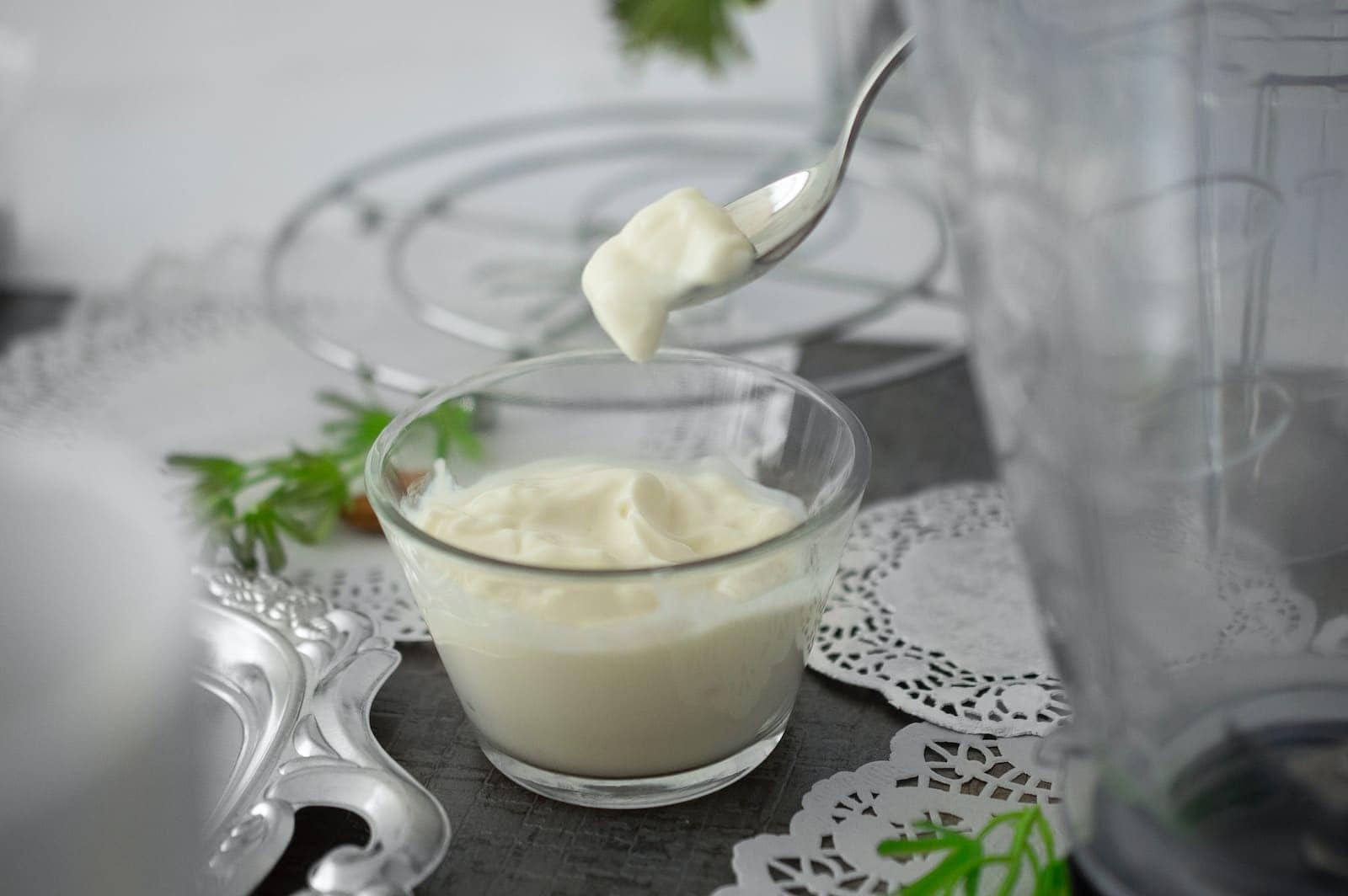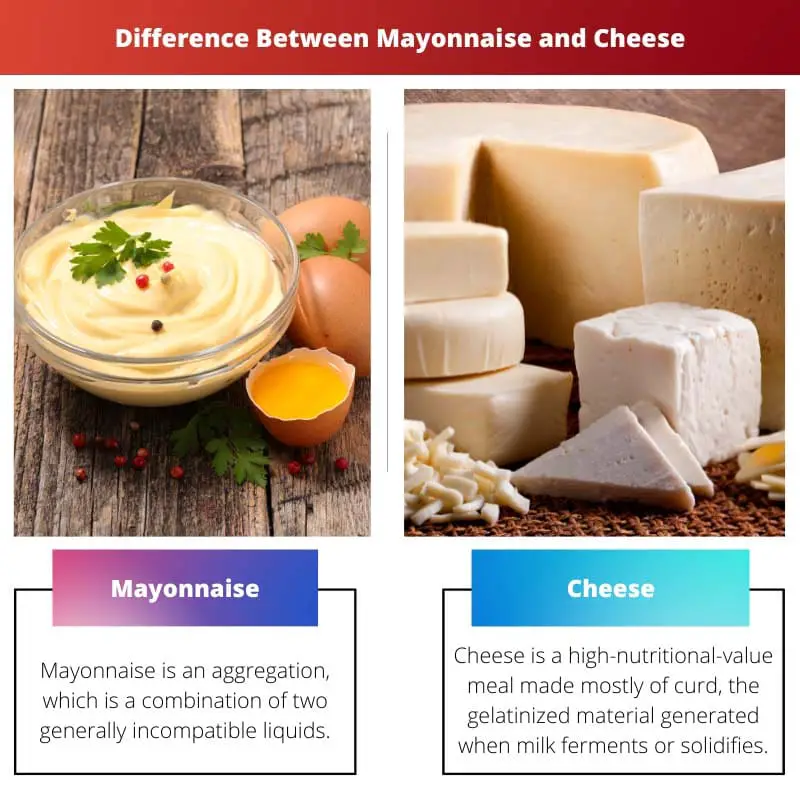Mayonnaise is made using egg yolks, balsamic, lemon zest, and oil. It can be used in place of butter and marmalade.
Mayonnaise is used to season spaghetti and salads. Mayonnaise is a popular condiment among children.
Cheese is a whole distinct food. Cheese is a type of pasteurized milk. It is a highly nutritious and healthful meal. To add flavor to the macaroni, use cheese as a pizza topping.
Mayonnaise and cheese are both nutritious foods.
Key Takeaways
- Mayonnaise is an emulsion of oil, egg yolk, vinegar or lemon juice, while cheese is a dairy product made from milk proteins and fat.
- Cheese is a solid food with various textures and flavors, whereas mayonnaise is a spreadable condiment with a smooth and creamy consistency.
- Mayonnaise enhances the taste and moisture of dishes, while cheese is a versatile ingredient with various culinary applications.
Mayonnaise vs Cheese
Mayonnaise is a thick, creamy sauce that is made from oil, egg yolks, vinegar or lemon juice, and seasonings. It is commonly used as a spread for sandwiches. Cheese is a dairy product made from milk. It is produced by coagulating milk proteins and separating the solids from the liquid.

Mayonnaise is an aggregation, which is a combination of two incompatible liquids. A notable example is the combination of oil and water.
Emulsifying is accomplished by gently combining one component to another while vigorously swirling. This dissolves and suspends microscopic particles of one substance while dispersing and suspending small molecules of another.
Salad dressing, that does not include egg whites and is richer than mayonnaise, is not the exact thing.
Cheese is a high-nutritional-value meal made mostly of curd, the gelatinized material generated when milk ferments or solidifies.
If milk is not utilized quickly, it naturally curdles: it ciders, generating an alkaline curd that sheds whey, a dilute solution comprising the soluble ingredients, and it releases semisolid ricotta or crumbly cheese.
In certain parts of the world, cheese is indeed created by actually letting milk coagulate spontaneously or by combining milk with enzymes or compounds that convert it to curds and precipitate.
Comparison Table
| Parameters of Comparison | Mayonnaise | Cheese |
|---|---|---|
| Calories | In mayonnaise, the calories content is 680. | In cheese, the calories content is 350. |
| Carbohydrates | In mayonnaise, the carbohydrate content is 0.57 g. | In cheese, the carbohydrate content is 5.52 g. |
| Fat | In mayonnaise, the fat content is 74.85 g. | In cheese, the fat content is 34.44 g. |
| Protein | In mayonnaise, the protein content is 0.96 g. | In cheese, the protein content is 6.15 g. |
| Water | In mayonnaise, the water content is 21.65 g. | In cheese, the water content is 52.62 g. |
What is Mayonnaise?
Mayonnaise is prepared by mixing eggshells with lime juice or balsamic. Eggs carrying the surfactant lecithin bond the components and keep them from separating.
The oil is then added and the combination while the mixture is stirred briskly. Too much oil or inadequate, fast whipping will prevent the liquid components from mixing.
However, when the sauce thickens, the oil may be injected more quickly. Following all of the butter has been incorporated, the ingredients are stirred in.
Blenders, grinders, and food manufacturers make it simple to produce organic mayonnaise, something that many connoisseurs believes tastes and is more consistent than retail mayonnaise.
Because homemade mayonnaise is unprocessed, choose the healthiest eggs you can find, as well as those you are relatively certain, are salmonella-free. In the freezer, homegrown mayonnaise can keep for three to four days.
Mayonnaise is the foundation for many sauces, including marinara sauce and thousand-island ranch vinaigrette.
Apart from reduced-fat and morbidly obese mayonnaises, commercial mayonnaise includes at least 65 percent oil by bulk and can be stored in the fridge for up to 12 weeks.
In addition, the legislation stipulates that all produced “genuine mayonnaise” utilize solely yolk as an agitator. Genetically engineered crops starch, gelatine gel, and other humectant and emulsifiers are common ingredients in low-fat mayonnaise.
Aioli is garlicky mayonnaise. Hollandaise, a prepared combination of butter, eggs, and citrus juice, is another traditional emulsion condiment.

What is Cheese?
Cheese-making most likely began soon after humankind first obtained milk from untamed or tamed animals. The Bible Mentions King David receiving “camembert of the cattle.”
By around 1000 BCE, unpasteurized milk and, probably, other mammals were being used to make cheese. The cheese was known and cherished by the antiquity Greeks and Romans, as well as by early Europeans.
Cheese-making techniques are frequently kept under wraps.
Cheese production is an important preservation method since it lowers approximately 10 gallons of yogurt to one quantity of cheese.
The curd, or squishy gel, is created by casein, the main peptide in milk, when sufficient fermented acid is produced from glucose by the milk’s microbes or whether it is worked upon by lactoferrin.
At the time of aggregation, the curd contains all of the dairy ingredients, comprising the majority of the fat, glutenin, and many other water-insoluble compounds.
Hundreds of cheeses are produced from cow’s dairy, calves, lambs, water buffalo, ponies, alpacas, and yaks. The commodities differ depending on the milk’s composition and processing, as well as the bulk density modification, heating, or pasteurization.
Warmth, duration, intensity for coagulation, gelatine, hydrochloric proportions, and the velocity and degree of whey extraction all influence curd development.
Cheese is described as raw or green before it ripens; once it ripens, it is described as treated, matured, or ripened.

Main Differences Between Mayonnaise and Cheese
- In Mayonnaise, the Calcium amount is 8 mg. Cheese, on the other hand, amounts to 97 mg of Calcium.
- In Mayonnaise, the Iron amount is 0.21 mg. Cheese, on the other hand, amounts to 0.11 mg of Iron.
- In Mayonnaise, the Magnesium amount is 1 mg, Cheese, on the other hand, amounts to 9 mg of Magnesium.
- In Mayonnaise, the Potassium amount is 20 mg. Cheese, on the other hand, amounts to 132 mg of Potassium.
- In Mayonnaise, the Sodium amount is 635 mg. Cheese, on the other hand, amounts to 314 mg of Sodium

- https://link.springer.com/article/10.1007/s00217-005-0230-8
- https://www.sciencedirect.com/science/article/pii/S0958694605002499
